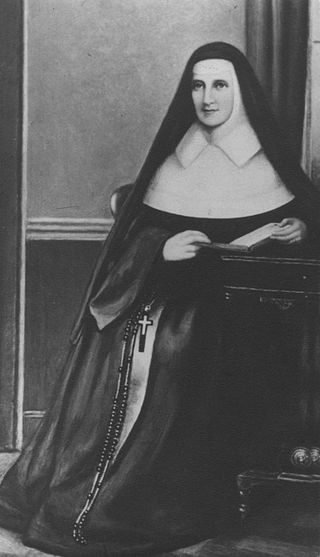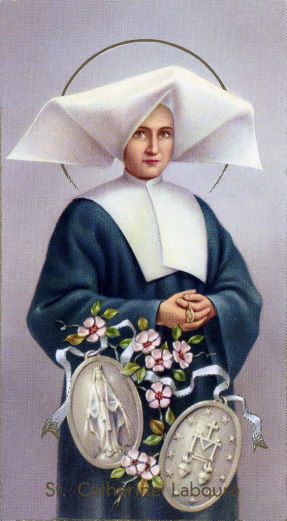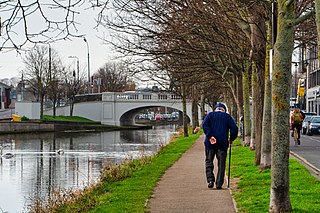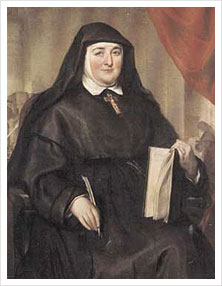
The Sisters of Mercy is a religious institute of Catholic women founded in 1831 in Dublin, Ireland, by Catherine McAuley. As of 2019, the institute has about 6200 sisters worldwide, organized into a number of independent congregations. They also started many education and health care facilities around the world.

Catherine Labouré, DC was a French member of the Daughters of Charity of Saint Vincent de Paul and a Marian visionary. She is believed to have relayed the request from the Blessed Virgin Mary to create the famous Miraculous Medal of Our Lady of Graces worn by millions of people around the world. Labouré spent forty years caring for the aged and infirm. For this, she is called the patroness of seniors.

Catherine McAuley, RSM was an Irish Catholic religious sister who founded the Sisters of Mercy in 1831. The women's congregation has always been associated with teaching, especially in Ireland, where the sisters taught Catholics at a time when education was mainly reserved for members of the established Church of Ireland.

Harold's Cross is an affluent urban village and inner suburb on the south side of Dublin, Ireland in the postal district D6W. The River Poddle runs through it, though largely in an underground culvert, and it holds a major cemetery, Mount Jerome, and Our Lady's Hospice.

Mother Mary Frances Aikenhead was born in Daunt's Square off Grand Parade, Cork, Ireland. Described as one of nursing's greatest leaders, she was the founder of the Catholic religious institute, the Religious Sisters of Charity, the Sisters of Charity of Australia, and of St. Vincent's Hospital in Dublin.
Beaumont is a northside suburb of Dublin city, Ireland, bordered by Donnycarney, Santry and Artane. It lies within the postal district of Dublin 9.
Events from the year 1879 in Ireland.
St. Francis Hospice, Raheny, Dublin is a specialist palliative care service, including an in-patient unit, and home care and day care services. The Hospice, one of two main hospice organisations in Dublin, provides care in a region with a population of c. 500,000 people.

The Connolly Hospital Blanchardstown is a teaching hospital in Blanchardstown, Dublin, Ireland. It is managed by RCSI Hospitals.

The Order of Our Lady of Charity is a Roman Catholic monastic order, founded in 1641 by John Eudes, at Caen, France. There are two branches of the congragation: contemplative, and apostolic, involved in ministries primarily with women and children around the world.
National Orthopaedic Hospital Cappagh, situated in Finglas, Dublin, is the largest orthopaedic hospital in Ireland. It is managed by Ireland East Hospital Group.
The Religious Sisters of Charity or Irish Sisters of Charity is a Roman Catholic religious institute founded by Mary Aikenhead in Ireland on 15 January 1815. Its motto is Caritas Christi urget nos.

The Sisters of Charity of Australia, or the Congregation of the Religious Sisters of Charity of Australia, is a congregation of religious sisters in the Catholic Church who have served the people of Australia since 1838. Sisters use the post-nominal initials of RSC.
Sarah Atkinson was an Irish writer, biographer, essayist and philanthropist.
The Dublin Live Art Festival is an annual event, created in order to support and promote live Performance Art in Ireland.
Susie Long was a 41-year-old woman who died from cancer at Our Lady's Hospice in Harold's Cross, Dublin, on 12 October 2007. Her death followed a long campaign to overhaul cancer treatment services in Ireland's ailing health system. An expatriate from Ohio, U.S., her remains were cremated at Mount Jerome Cemetery. Long's campaign is credited with persuading then Health Minister Mary Harney to provide funding for a new 24-bed day unit at St Luke's Hospital. Taoiseach Bertie Ahern also acknowledged that Long had been failed.

Sister Katherine Butler was an Irish nun with the Religious Sisters of Charity, teacher, writer, and aviator. Butler was one of the first women to get a pilot's licence in Ireland.
Anna Gaynor or Mother Mary John was an Irish Religious Sister of Charity and first superior of Our Lady's Hospice, Harold's Cross, Dublin.
Catherine Cummins or Mother Mary Polycarp was an Irish Sister of Charity nun and founder member of Cappagh Orthopaedic Hospital.

Pearl Phelan, Sr Joseph Ignatius was a nurse and pioneer of person-centred hospice care, known to many as "Aunt Pearl". In her role at Our Lady's Hospice in Harold's Cross, Dublin, she modernised the facility and transformed end-of-life and palliative care. She introduced the hospice Home Care service so people could die in their own homes. For her initiatives in enabling people to "live life to the full, control their symptoms so they are freed from pain and fear of pain", she received the People of the Year Award in 1987.









